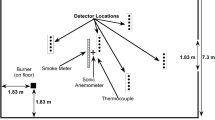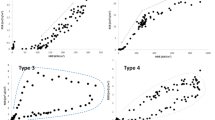Abstract
Smoke deposition from a hot smoke layer onto wall surfaces was studied in a hood apparatus using polymethylmethacrylate, polypropylene, and gasoline as fuels. Based upon prior analysis by Butler and Mulholland, the smoke deposition was expected to be dominated by thermophoresis. The deposited smoke samples were collected on glass filter paper attached to the hood wall and the mass per unit area of smoke deposited was measured gravimetrically. Measurements were made of quantities required for the prediction of thermophoretic smoke deposition. The smoke deposition measured in the experimental program was well predicted by the thermophoretic smoke deposition equation. The thermophoretic smoke deposition equation was found to be suitable for predicting smoke deposition onto wall surfaces exposed to fire environments.







Similar content being viewed by others
References
Butler K, Mulholland G (2004) Generation and transport of smoke components. Fire Technol 40(2): 149–176. doi:10.1023/B:FIRE.0000016841.07530.64
Mulholland GW (2002) Smoke production and properties. The SFPE handbook of fire protection engineering. National Fire Protection Association, Quincy, pp. 258–268
Ciro W, Eddings E, Sarofim A (2006) Experimental and numerical investigation of transient soot buildup on a cylindrical container immersed in a jet fuel pool fire, Combust Sci Technol 178(12): 2199–2218. doi:10.1080/00102200600626108
Sippola MR, Nazaroff WW (2005) Particle deposition in ventilation ducts: connectors, bends and developing turbulent flow. Aerosol Sci Technol 39:139–150. doi:10.1080/027868290908759
Guha A (1997) A unified Eulerian theory of turbulent deposition to smooth and rough surfaces. J Aerosol Sci 28:1517–1537. doi:10.1016/S0021-8502(97)00028-1
Gottuk D, Mealy C, Floyd J (2009) Smoke transport and FDS validation. Fire Saf Sci 9: 129–140. doi:10.3801/IAFSS.FSS.9-129
Hamins A, Maranghides A, Johnsson EL, Donnelly MK, Yang JC, Mulholland GW, Anleitner RL (2005) Report of experimental results for the international fire model benchmarking and validation exercise #3. National Institute of Standards and Technology, Gaithersburg
Floyd J (2010) Modeling soot deposition using large eddy simulation with a mixture fraction based framework, Interflam 2010. Interscience Communications, London
Riahi S, Beyler C (2011) Measurement and prediction of smoke deposition from a fire against a wall. Fire Saf Sci 10: 641–654. doi:10.3801/IAFSS.FSS.10-641
Riahi S (2010) New tools for smoke residue and deposition analysis. PhD Dissertation, Department of Civil and Environmental Engineering, The George Washington University, Washington DC
Properties for the duraboard Fiberfrax from http://www.fiberfrax.com/. Accessed 24 may 2012
ASTM (2004) PTC. 19.5 Flow Measurement
Talbot L, Cheng R, Schefer R, Willis D (2006) Thermophoresis of particles in a heated boundary layer. J Fluid Mech 101(04): 737. doi:10.1017/S0022112080001905
Waldmann L, Schmitt K (1966) Aerosol science. Academic Press, New York
Brock J, (1962) On the theory of thermal forces acting on aerosol particles. J Colloid Sci 17(8): 768–780. doi:10.1016/0095-8522(62)90051-X
Friedlander S (2000) Smoke, dust, and haze: fundamentals of aerosol dynamics. Oxford University Press, New York
Mulholland GW, Croarkin C (2000) Specific extinction coefficient of flame generated smoke. Fire Mater 24:227–230. doi:10.1002/1099-1018(200009/10)24:5<227::AID-FAM742>3.0.CO;2-9
Hartman JR, Beyler AP, Riahi S, Beyler CL (2011) Smoke oxidation kinetics for application to prediction of clean burn patterns. Fire Mater. doi:10.1002/fam.1099
Author information
Authors and Affiliations
Corresponding author
Rights and permissions
About this article
Cite this article
Riahi, S., Beyler, C.L. & Hartman, J. Wall Smoke Deposition from a Hot Smoke Layer. Fire Technol 49, 395–409 (2013). https://doi.org/10.1007/s10694-012-0273-x
Received:
Accepted:
Published:
Issue Date:
DOI: https://doi.org/10.1007/s10694-012-0273-x




